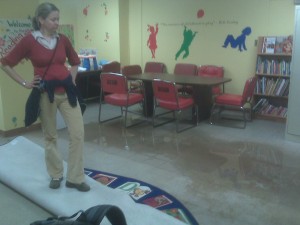LISTEN TO JAMILA LARSON
Audio clip: Adobe Flash Player (version 9 or above) is required to play this audio clip. Download the latest version here. You also need to have JavaScript enabled in your browser.
Sitting in a room intended for babies, but filled with what smelled like sewage, Jamila Larson sat down for an extended conversation about homelessness and children. As she endured the stench coming from the library/babies’ room her organization had worked so hard create, Larson discussed the founding of the Homeless Children’s Playtime Project in 2003, Councilmember Tommy Wells’ effort to require proof of District residency in order to receive shelter, and much more.
The genesis for the Playtime Project can be traced back to an experience Larson had at the CCNV shelter in downtown D.C. in 1999. It was the holiday season, Larson said, “[and we felt] the least we could do is give gifts to the children who live there for the holidays. I didn’t see any toys, so I asked this woman, ‘Doesn’t anyone ever donate any toys?’ I just saw rows of bunk beds and sheets for doors and kids kind of languishing in the hallways, and she said, ‘Yeah, we get toys from time to time, but we keep them locked in a closet so the kids don’t make a mess.’ So that’s literally how the Playtime Project started. We realized that it wasn’t enough to give toys. We had to literally provide the space for those toys to be used and the people to defend a child’s right to play [in order] to provide them that opportunity to use the room where the toys are. So we really had very, very humble beginnings.”
From those humble beginnings, the organization has overcome one obstacle after another. While the Playtime Project serves families at five locations, nowhere has it faced greater difficulties than at the shelter on the site of the former D.C. General Hospital. As she examined the foul-smelling, standing water in the babies’ room, Larson said, “Some of our volunteers compared it to the room where the elephants live at the zoo. There’s a really pungent odor right now. When we showed up for playtime… [and] opened the door to this particular playroom – it’s our library and baby room – [we] were shocked to discover about a fourth of the room covered in an enormous puddle of what looks and smells like urine and sewage that appears to be dripping from the lights.”
When there are news reports documenting poor conditions at a D.C. shelter, instead of making the needed improvements, too often the District government moves to close the shelter, as it did with the Randall, Franklin and La Casa shelters in recent years. Therefore, activists must walk a fine line: too much attention to a problem may result in a shelter’s closure, while too little attention may result in no change at all.
Larson said of the shelter at D.C. General, “I can’t think of another facility large enough to house 200 families. This is as good as we got right now so we have to make it the best possible place. I definitely get concerned when I hear about people saying that we have to close down D.C. General. Because obviously no one would choose to live here if they weren’t absolutely desperate, but if we close it down where are all those families going to go? There are more than 400 families on the waiting list for shelter. Last I heard, [there were] about 47 families on the Tier 1 list, which means they have absolutely nowhere to go. They’re sleeping in public spaces and Greyhound bus stations, riding the Metro bus all night, sleeping under bridges. These are families with children. So D.C. General is a lifeline right now. It’s as good as we got, unfortunately. And it frustrates me that the city doesn’t want to fully invest in what it takes to run a decent shelter here because there are families that really depend on it.”
Update: The Department of Human Services has responded to requests to sanitize the babies’ room at the shelter at D.C. General. In an email to TheFightBack.org on Friday, Larson wrote, “I am pleased to report that a lot of progress was made… I’ve gotten a lot of messages from DHS staff today, all with the same email footer about spotting and reporting terrorism. (Does sewage sludge count?)”

